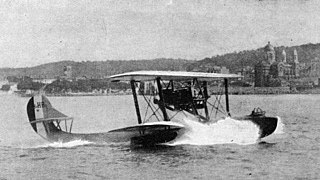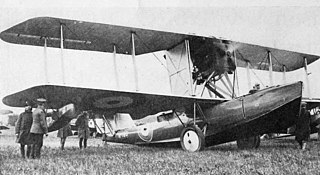Operators
 German Empire
German Empire
- Kaiserliche Marine (Marinefliegerkorps)
| W.23 | |
|---|---|
| Role | Flying-boat fighter |
| Manufacturer | Hansa und Brandenburgische Flugzeug-Werke |
| Designer | Ernst Heinkel |
| First flight | 1917 |
| Introduction | June 1917 |
| Number built | 3 |
The Hansa-Brandenburg W.23 was a German flying-boat fighter of World War I.
The W.23 followed the design philosophy for all flying boat biplanes built by Hansa-Brandenburg, including a swept lower wing, wing floats, pusher engine arrangement, and a single-step hull. Although similar to design to the Hansa-Brandenburg W.18, it differed in having a longer fuselage. Three aircraft (MN 1647-1649) were delivered from June 1917 to January 1918, but flight characteristics were deemed poor. [1]
Data from Hansa-Brandenburg : Aircraft of WW InVolume 2, Biplane Seaplanes [2]
General characteristics
Performance
Armament
Related lists

Grigorovich M-9 was a Russian World War I-era biplane flying boat, developed from the M-5 by Grigorovich.

The Hansa-Brandenburg W.12 was a German biplane fighter floatplane of World War I. It was a development of Ernst Heinkel's previous KDW, adding a rear cockpit for an observer/gunner, and had an unusual inverted tailfin/rudder in order to give an uninterrupted field of fire.

The SIAI S.8 was an Italian 1910s two-seat reconnaissance flying boat.

The Blanchard Brd.1 was a French reconnaissance flying boat, to the 1923 STAé HB.3 specification, used by the French navy in the 1920s. It was a large biplane with two engines mounted in the gap between the wings, each engine driving a pusher propeller. In 1924, one Brd.1 was used to set several world altitude records for seaplanes.
The Friedrichshafen FF.43 was a German single-seat floatplane fighter of the 1910s produced by Flugzeugbau Friedrichshafen.

The Friedrichshafen FF.48 was a German two-seat floatplane fighter of the 1910s produced by Flugzeugbau Friedrichshafen.

The Hansa-Brandenburg W.19 was a German fighter-reconnaissance aircraft of World War I. It was a single-engined two-seat biplane floatplane, and was a larger development of the successful W.12. It served with the Kaiserliche Marine during 1918.

The Hansa-Brandenburg CC was a single-seat German fighter flying boat of World War I. It was used by both the Kaiserliche Marine and the Austro-Hungarian Navy.

The Lohner L was a reconnaissance flying boat produced in Austria-Hungary during World War I. It was a two-bay biplane of typical configuration for the flying boats of the day, with its pusher engine mounted on struts in the interplane gap. The pilot and observer sat side by side in an open cockpit, and both the upper and lower sets of wings featured sweepback.

The Hansa-Brandenburg W.11 was a fighter floatplane built in Germany in 1917 as a more powerful version of the KDW. Similar in general configuration to its predecessor, the W.11 shared the same unusual interplane strut arrangement, and featured fins above and below the fuselage. Only three examples were built.

The Hansa-Brandenburg W.13 was a flying boat bomber developed in Germany in 1917 and used by the Austro-Hungarian Navy during World War I.

The Hansa Brandenburg W.27 and W.32 were prototype fighter floatplanes developed in parallel in Germany during World War I. They were developments of and intended replacements for the W.12 then in service and differed from each other principally in the choice of powerplant, the W.27 with a Benz Bz.IIIb and the W.32 with the same Mercedes D.III that the original W.12 used.

The Hansa-Brandenburg W.20 was a German submarine-launched reconnaissance flying boat of the World War I era, designed and built by Hansa-Brandenburg.

The Supermarine Sheldrake was a British amphibian biplane flying boat developed by Supermarine from the Supermarine Seagull with a revised hull. It was powered by a Napier Lion engine mounted between the wings driving a four-bladed propeller. Only one Sheldrake, serial number N180, was built.
The Oeffag G , sometimes known as the Oeffag Type G or Oeffag-Mickl G, was a three-engined reconnaissance flying boat built in Austria during the First World War and deployed by the Kaiserlich und Königlich Seefliegerkorps.

The Zeppelin-Lindau CS.I was a German single-engined reconnaissance seaplane with a low-wing monoplane layout.
The Hansa-Brandenburg GDW was a floatplane torpedo bomber built in Germany during World War I for the Imperial German Navy.
The Hansa-Brandenburg W.16 was a floatplane fighter built in Germany during World War I for the Imperial German Navy.

The Hansa-Brandenburg W.18 was a single-seat German fighter flying boat of World War I. It was used by both the Kaiserliche Marine and the Austro-Hungarian Navy.
The Hansa-Brandenburg W.25 was a German floatplane fighter of the World War I era, designed and built by Hansa-Brandenburg.